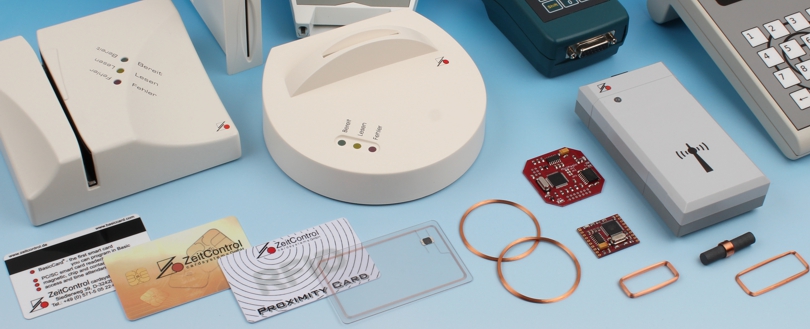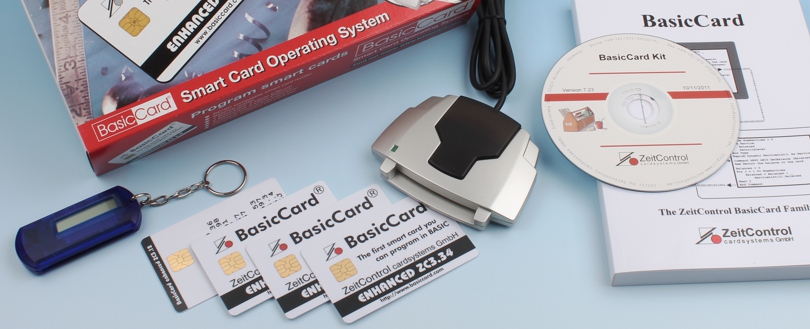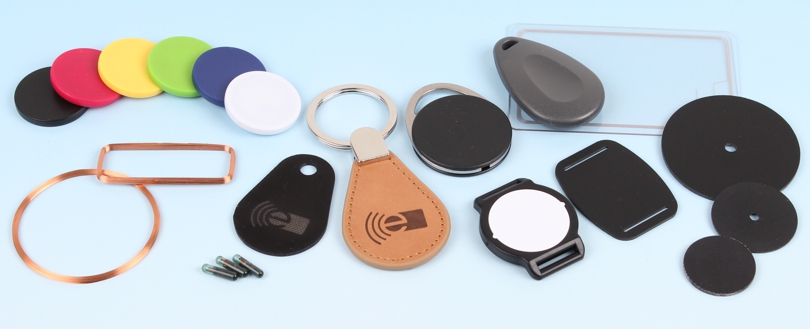


Hardware and OEM components for magnetic cards, chip cards and RFID transponder technology
BasicCard® is the first smart card you can program in BASIC. Developers can create their own smart card application within only a few hours. Our development kits contain everything needed for your startup.
RFID transponder tags in various shapes and assorted transponder types e.g. EM4102, EM4450, Hitag-1, Hitag-2, Hitag-S, MIFARE® Classic, MIFARE® DESFire®, I-Code, Legic, ...
Seit “Erfindung” der Kreditkarte (Diners-Club) genießen Magnetkarten weltweites Vertrauen im bargeldlosen Zahlungsverkehr.
Diese preisgünstige Karte in Verbindung mit den geringen Kosten für entsprechende Lesegeräte machen die Magnetkarten zu einem unschlagbaren Identifikationsmittel für z.B. Zeiterfassungen, Zutrittskontrollen und BDE- Anwendungen, aber auch in Kundenbindungssystemen (z.B. Bonuskarten).
Die ISO-Normen 7810 und 7811 normen die physikalischen Abmessungen der Karte und die Codierung der Daten. Dies garantiert eine hohe Kompatibilität und einfache technische Anbindung, die den Anwendungsentwickler nicht unnötig Zeit kostet.
Während die ISO-7810 die Abmessungen einer Plastikkarte definiert, legt die ISO-7811 u.a. die Position des Magnetstreifen auf der Karte fest. Dieser Norm entsprechend beinhaltet der Magnetstreifen 3 sogenannte Spuren, in denen die Daten kodiert werden können. Ebenso legt diese ISO-Norm fest, welche Zeichensätze für die einzelnen Spuren verwendet werden dürfen und wie diese zu kodieren sind.
Generell existieren zwei Typen von Magnetkarten: LoCo- und HiCo-Karten. Diese Typen unterscheiden sich in der Magnetiesierbarkeit der Magnetstreifen, also in der “Kraft” die nötig ist, um die Daten auf den Magnetstreifen zu schreiben. Diese Kraft wird in “Oerstedt” (oder kurz: “Oe.”) angegeben. LoCo-Magnetkarten werden mit 300 Oe. codiert, HiCo-Karten werden mit 4.000 Oe. codiert. Etwa 95% aller am Markt befindlichen Magnetkarten sind LoCo-Karten. Für normale Umgebungen sind LoCo- Karten völlig ausreichend. Die seit mehreren Jahrzehnten bekannten Kreditkarten und Bankkarten geben hier Zeugnis. HiCo-Karten finden dort Einsatz, wo mit starken magnetischen Störfeldern zu rechnen ist, die den Dateninhalt auf LoCo-Karten löschen könnten (z.B. für Zeiterfassungskarten für Mitarbeiter in Galvanisierbetrieben). Diese beiden Standards sind untereinander nicht kompatibel. Die Geräte müssen zu den Karten passen! LoCo-Karten funktionieren nicht in HiCo-Lesegeräten und umgekehrt.
Auf dem Magnetstreifen stehen Ihnen drei Spuren oder Tracks zur Datenspeicherung zur Verfügung. Da sich die Spuren in Bezug auf Zeichensatz und Schreibdichte unterscheiden variiert die Menge des zur Verfügung stehenden Speicherplatzes. So ist z.B. auf Spur-2 mit 75 bpi (“bpi”=Bits Per Inch) die Datendichte relativ gering: Es können nur 40 numerische Zeichen gespeichert werden. Aber gerade die geringe Datendichte ermöglicht es, diese Daten auch noch unter ungünstigen Bedingungen (abgenutzter Magnetkopf etc.) fehlerfrei zu lesen. Die Spur-2 wird daher auch die Sicherheitsspur genannt. Welche Zeichen verwendet werden dürfen und wieviel davon auf die jeweilige Spur passen können Sie der folgenden Tabelle entnehmen:
| Spur | Codierungsvorschrift | Datendichte | Zeichensatz |
| 1 | IATA | 210 bpi, 7 bits / Zeichen | 79 alphanumerische Zeichen (a, b, c, ..., 1, 2, 3, ...) |
| 2 | ABA | 75 bpi, 5 bits / Zeichen | 40 numerische Zeichen (1,2, 3, ...) |
| 3 | THRIFT | 210 bpi, 5 bits / Zeichen | 107 numerische Zeichen (1,2, 3, ...) |
In unserem Shop finden Sie Informationen zu unseren Magnetkarten-Lese- und Schreibgeräten, als OEM-Baugruppen oder anschlußfertigen Geräten.
Zu Fragen und weiteren Informationen stehen Ihnen unsere Techniker gerne zur Verfügung. Kontaktieren Sie uns.
ZeitControl cardsystems has expanded its range of industrial R FID readers with the CDC (Communications Device Class) option. More commonly known as virtual COM port.
Please email me the latest information on your product portfolio regularly and in accordance with your data privacy notice. I recognise that I can revoke my permission to receive said emails at any time.
By selecting "Accept all", you give us permission to use the following services on our website: YouTube, Vimeo, ReCaptcha. You can change the settings at any time (fingerprint icon in the bottom left corner). For further details, please see Individual configuration and our Privacy notice.
The settings you specify here are stored in the "local storage" of your device. The settings will be remembered for the next time you visit our online shop. You can change these settings at any time (fingerprint icon in the bottom left corner).
For more information on cookie lifetime and required essential cookies, please see the Privacy notice.
To view YouTube contents on this website, you need to consent to the transfer of data and storage of third-party cookies by YouTube (Google). This allows us to improve your user experience and to make our website better and more interesting. Without your consent, no data will be transferred to YouTube. However, you will also not be able to use the YouTube services on this website.
To view Vimeo contents on this website, you need to consent to the transfer of data and storage of third-party cookies by Vimeo.. This allows us to improve your user experience and to make our website better and more interesting. Without your consent, no data will be transferred to Vimeo. However, you will also not be able to use the Vimdeo services on this website.
To submit forms on this page, you need to consent to the transfer of data and storage of third-party cookies by Google. With your consent, reCAPTCHA, a Google service to avoid spam messages via contact forms, will be embedded. This service allows us to provide our customers with a safe way to contact us via online forms. At the same time, the service prevents spam bots from compromising our services. After you gave your permission, you might be asked to answer a security prompt to send the form. If you do not consent, unfortunately you cannot use the form. Please contact us in a different way.
Would you like to see these contents? Activate the desired contents for one session only or allow the website to remember these settings. Once you have given your consent, the third-party data can be loaded. For this, third-party cookies might be stored on your device. You can change these settings at any time (fingerprint icon in the bottom left corner). For further details, please see the Privacy notice.
